Effective Nursing Practices Assessment 2022
VerifiedAdded on 2022/09/26
|9
|2857
|26
AI Summary
Contribute Materials
Your contribution can guide someone’s learning journey. Share your
documents today.

Running head: EFFECTIVE NURSING PRACTICES 1
Effective Nursing Practices
Name
Institutional Affiliation
Effective Nursing Practices
Name
Institutional Affiliation
Secure Best Marks with AI Grader
Need help grading? Try our AI Grader for instant feedback on your assignments.
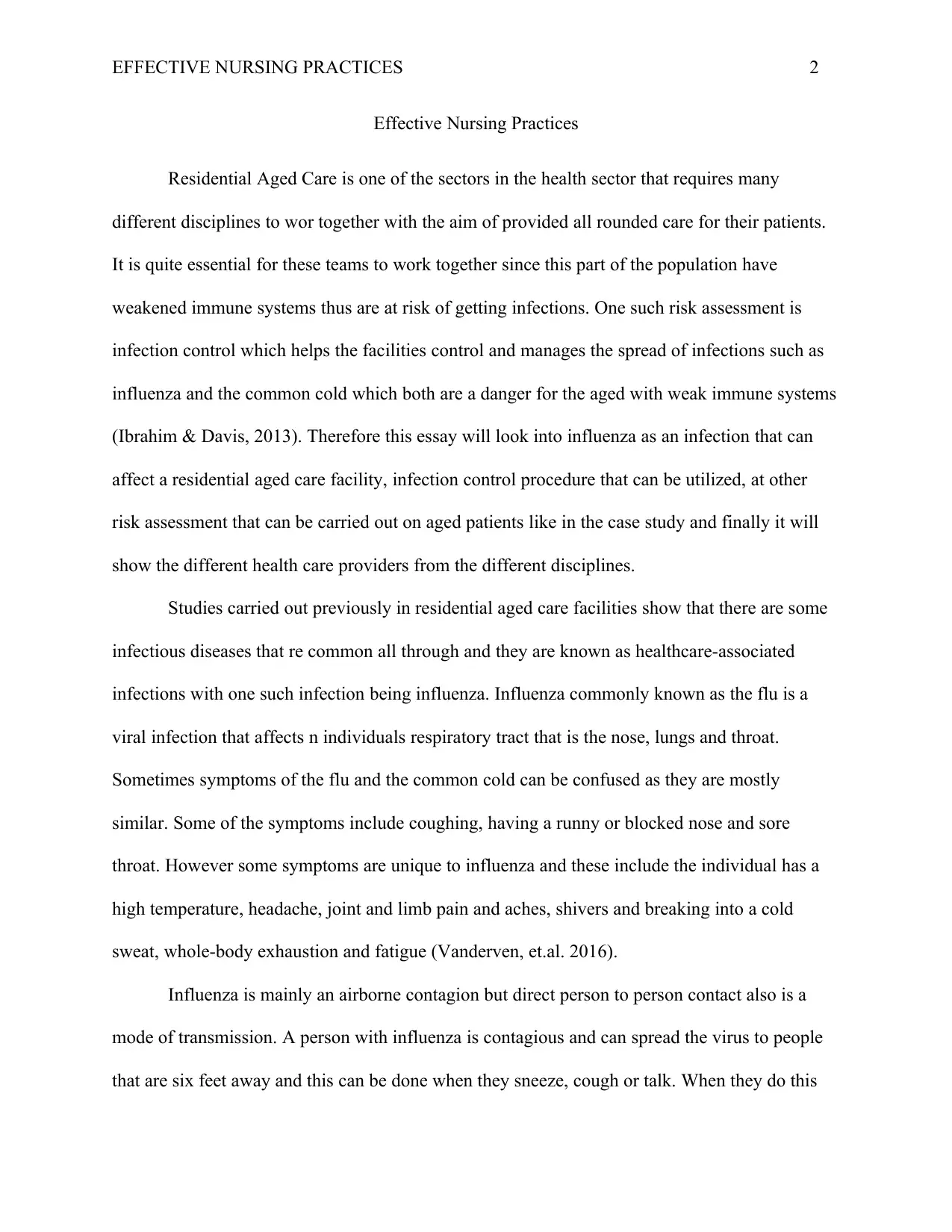
EFFECTIVE NURSING PRACTICES 2
Effective Nursing Practices
Residential Aged Care is one of the sectors in the health sector that requires many
different disciplines to wor together with the aim of provided all rounded care for their patients.
It is quite essential for these teams to work together since this part of the population have
weakened immune systems thus are at risk of getting infections. One such risk assessment is
infection control which helps the facilities control and manages the spread of infections such as
influenza and the common cold which both are a danger for the aged with weak immune systems
(Ibrahim & Davis, 2013). Therefore this essay will look into influenza as an infection that can
affect a residential aged care facility, infection control procedure that can be utilized, at other
risk assessment that can be carried out on aged patients like in the case study and finally it will
show the different health care providers from the different disciplines.
Studies carried out previously in residential aged care facilities show that there are some
infectious diseases that re common all through and they are known as healthcare-associated
infections with one such infection being influenza. Influenza commonly known as the flu is a
viral infection that affects n individuals respiratory tract that is the nose, lungs and throat.
Sometimes symptoms of the flu and the common cold can be confused as they are mostly
similar. Some of the symptoms include coughing, having a runny or blocked nose and sore
throat. However some symptoms are unique to influenza and these include the individual has a
high temperature, headache, joint and limb pain and aches, shivers and breaking into a cold
sweat, whole-body exhaustion and fatigue (Vanderven, et.al. 2016).
Influenza is mainly an airborne contagion but direct person to person contact also is a
mode of transmission. A person with influenza is contagious and can spread the virus to people
that are six feet away and this can be done when they sneeze, cough or talk. When they do this
Effective Nursing Practices
Residential Aged Care is one of the sectors in the health sector that requires many
different disciplines to wor together with the aim of provided all rounded care for their patients.
It is quite essential for these teams to work together since this part of the population have
weakened immune systems thus are at risk of getting infections. One such risk assessment is
infection control which helps the facilities control and manages the spread of infections such as
influenza and the common cold which both are a danger for the aged with weak immune systems
(Ibrahim & Davis, 2013). Therefore this essay will look into influenza as an infection that can
affect a residential aged care facility, infection control procedure that can be utilized, at other
risk assessment that can be carried out on aged patients like in the case study and finally it will
show the different health care providers from the different disciplines.
Studies carried out previously in residential aged care facilities show that there are some
infectious diseases that re common all through and they are known as healthcare-associated
infections with one such infection being influenza. Influenza commonly known as the flu is a
viral infection that affects n individuals respiratory tract that is the nose, lungs and throat.
Sometimes symptoms of the flu and the common cold can be confused as they are mostly
similar. Some of the symptoms include coughing, having a runny or blocked nose and sore
throat. However some symptoms are unique to influenza and these include the individual has a
high temperature, headache, joint and limb pain and aches, shivers and breaking into a cold
sweat, whole-body exhaustion and fatigue (Vanderven, et.al. 2016).
Influenza is mainly an airborne contagion but direct person to person contact also is a
mode of transmission. A person with influenza is contagious and can spread the virus to people
that are six feet away and this can be done when they sneeze, cough or talk. When they do this
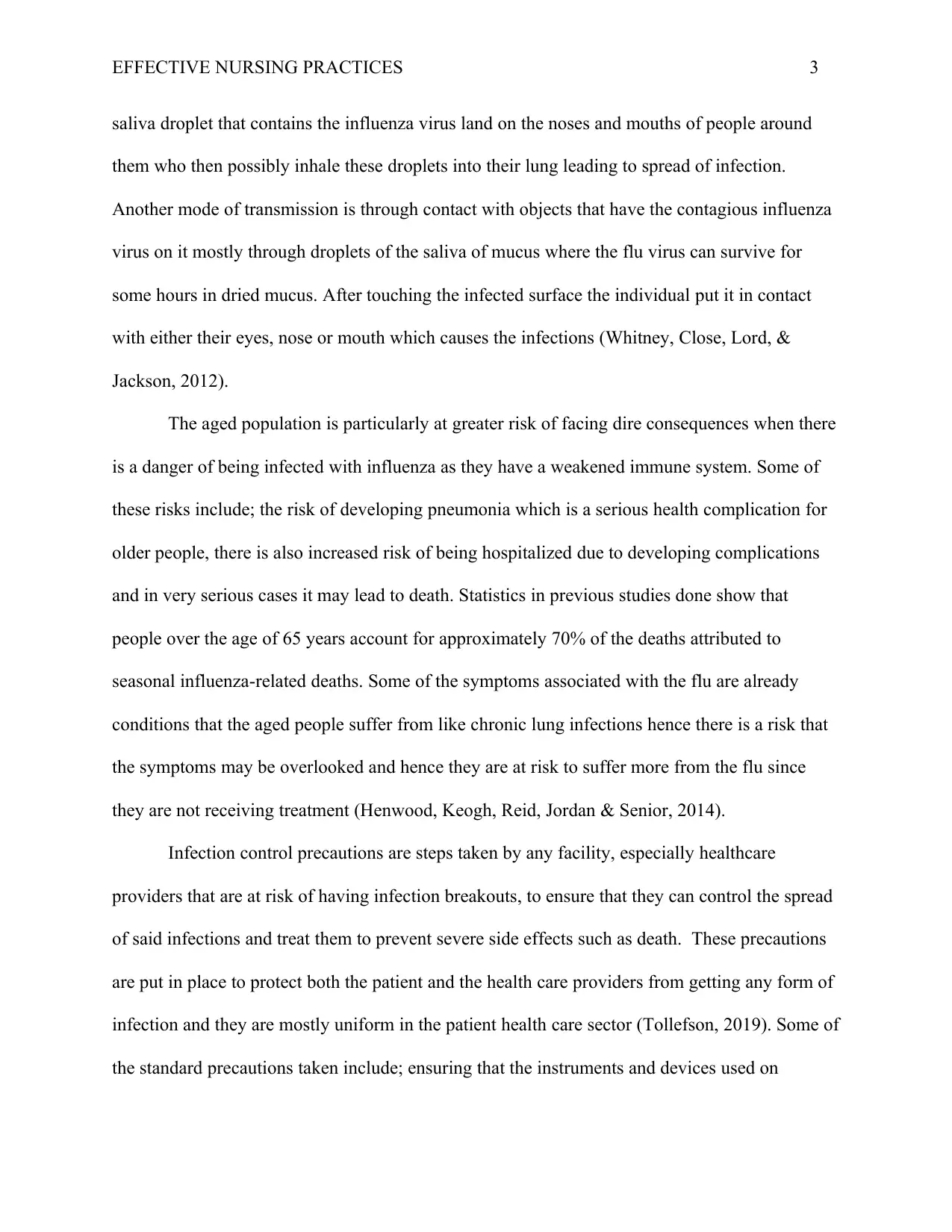
EFFECTIVE NURSING PRACTICES 3
saliva droplet that contains the influenza virus land on the noses and mouths of people around
them who then possibly inhale these droplets into their lung leading to spread of infection.
Another mode of transmission is through contact with objects that have the contagious influenza
virus on it mostly through droplets of the saliva of mucus where the flu virus can survive for
some hours in dried mucus. After touching the infected surface the individual put it in contact
with either their eyes, nose or mouth which causes the infections (Whitney, Close, Lord, &
Jackson, 2012).
The aged population is particularly at greater risk of facing dire consequences when there
is a danger of being infected with influenza as they have a weakened immune system. Some of
these risks include; the risk of developing pneumonia which is a serious health complication for
older people, there is also increased risk of being hospitalized due to developing complications
and in very serious cases it may lead to death. Statistics in previous studies done show that
people over the age of 65 years account for approximately 70% of the deaths attributed to
seasonal influenza-related deaths. Some of the symptoms associated with the flu are already
conditions that the aged people suffer from like chronic lung infections hence there is a risk that
the symptoms may be overlooked and hence they are at risk to suffer more from the flu since
they are not receiving treatment (Henwood, Keogh, Reid, Jordan & Senior, 2014).
Infection control precautions are steps taken by any facility, especially healthcare
providers that are at risk of having infection breakouts, to ensure that they can control the spread
of said infections and treat them to prevent severe side effects such as death. These precautions
are put in place to protect both the patient and the health care providers from getting any form of
infection and they are mostly uniform in the patient health care sector (Tollefson, 2019). Some of
the standard precautions taken include; ensuring that the instruments and devices used on
saliva droplet that contains the influenza virus land on the noses and mouths of people around
them who then possibly inhale these droplets into their lung leading to spread of infection.
Another mode of transmission is through contact with objects that have the contagious influenza
virus on it mostly through droplets of the saliva of mucus where the flu virus can survive for
some hours in dried mucus. After touching the infected surface the individual put it in contact
with either their eyes, nose or mouth which causes the infections (Whitney, Close, Lord, &
Jackson, 2012).
The aged population is particularly at greater risk of facing dire consequences when there
is a danger of being infected with influenza as they have a weakened immune system. Some of
these risks include; the risk of developing pneumonia which is a serious health complication for
older people, there is also increased risk of being hospitalized due to developing complications
and in very serious cases it may lead to death. Statistics in previous studies done show that
people over the age of 65 years account for approximately 70% of the deaths attributed to
seasonal influenza-related deaths. Some of the symptoms associated with the flu are already
conditions that the aged people suffer from like chronic lung infections hence there is a risk that
the symptoms may be overlooked and hence they are at risk to suffer more from the flu since
they are not receiving treatment (Henwood, Keogh, Reid, Jordan & Senior, 2014).
Infection control precautions are steps taken by any facility, especially healthcare
providers that are at risk of having infection breakouts, to ensure that they can control the spread
of said infections and treat them to prevent severe side effects such as death. These precautions
are put in place to protect both the patient and the health care providers from getting any form of
infection and they are mostly uniform in the patient health care sector (Tollefson, 2019). Some of
the standard precautions taken include; ensuring that the instruments and devices used on
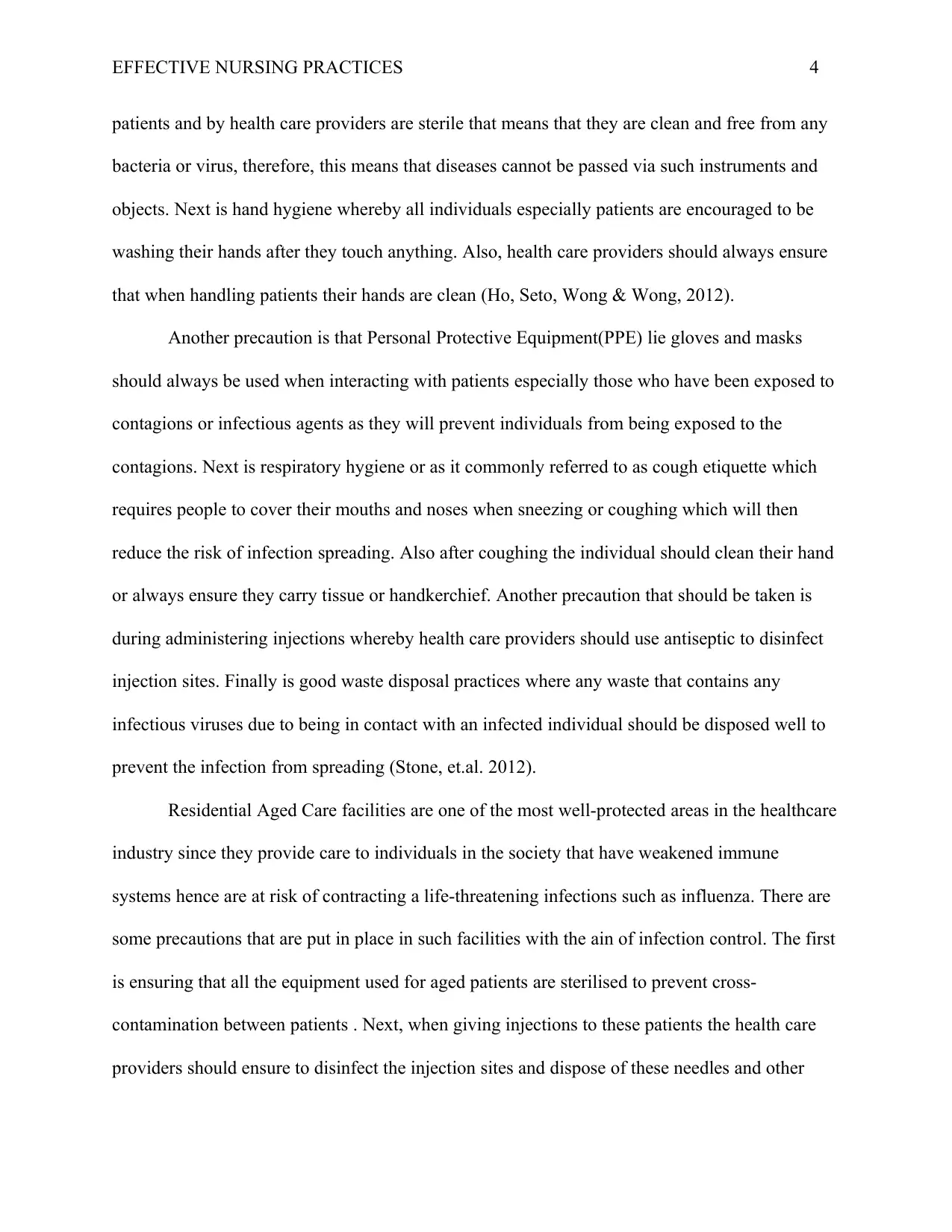
EFFECTIVE NURSING PRACTICES 4
patients and by health care providers are sterile that means that they are clean and free from any
bacteria or virus, therefore, this means that diseases cannot be passed via such instruments and
objects. Next is hand hygiene whereby all individuals especially patients are encouraged to be
washing their hands after they touch anything. Also, health care providers should always ensure
that when handling patients their hands are clean (Ho, Seto, Wong & Wong, 2012).
Another precaution is that Personal Protective Equipment(PPE) lie gloves and masks
should always be used when interacting with patients especially those who have been exposed to
contagions or infectious agents as they will prevent individuals from being exposed to the
contagions. Next is respiratory hygiene or as it commonly referred to as cough etiquette which
requires people to cover their mouths and noses when sneezing or coughing which will then
reduce the risk of infection spreading. Also after coughing the individual should clean their hand
or always ensure they carry tissue or handkerchief. Another precaution that should be taken is
during administering injections whereby health care providers should use antiseptic to disinfect
injection sites. Finally is good waste disposal practices where any waste that contains any
infectious viruses due to being in contact with an infected individual should be disposed well to
prevent the infection from spreading (Stone, et.al. 2012).
Residential Aged Care facilities are one of the most well-protected areas in the healthcare
industry since they provide care to individuals in the society that have weakened immune
systems hence are at risk of contracting a life-threatening infections such as influenza. There are
some precautions that are put in place in such facilities with the ain of infection control. The first
is ensuring that all the equipment used for aged patients are sterilised to prevent cross-
contamination between patients . Next, when giving injections to these patients the health care
providers should ensure to disinfect the injection sites and dispose of these needles and other
patients and by health care providers are sterile that means that they are clean and free from any
bacteria or virus, therefore, this means that diseases cannot be passed via such instruments and
objects. Next is hand hygiene whereby all individuals especially patients are encouraged to be
washing their hands after they touch anything. Also, health care providers should always ensure
that when handling patients their hands are clean (Ho, Seto, Wong & Wong, 2012).
Another precaution is that Personal Protective Equipment(PPE) lie gloves and masks
should always be used when interacting with patients especially those who have been exposed to
contagions or infectious agents as they will prevent individuals from being exposed to the
contagions. Next is respiratory hygiene or as it commonly referred to as cough etiquette which
requires people to cover their mouths and noses when sneezing or coughing which will then
reduce the risk of infection spreading. Also after coughing the individual should clean their hand
or always ensure they carry tissue or handkerchief. Another precaution that should be taken is
during administering injections whereby health care providers should use antiseptic to disinfect
injection sites. Finally is good waste disposal practices where any waste that contains any
infectious viruses due to being in contact with an infected individual should be disposed well to
prevent the infection from spreading (Stone, et.al. 2012).
Residential Aged Care facilities are one of the most well-protected areas in the healthcare
industry since they provide care to individuals in the society that have weakened immune
systems hence are at risk of contracting a life-threatening infections such as influenza. There are
some precautions that are put in place in such facilities with the ain of infection control. The first
is ensuring that all the equipment used for aged patients are sterilised to prevent cross-
contamination between patients . Next, when giving injections to these patients the health care
providers should ensure to disinfect the injection sites and dispose of these needles and other
Secure Best Marks with AI Grader
Need help grading? Try our AI Grader for instant feedback on your assignments.
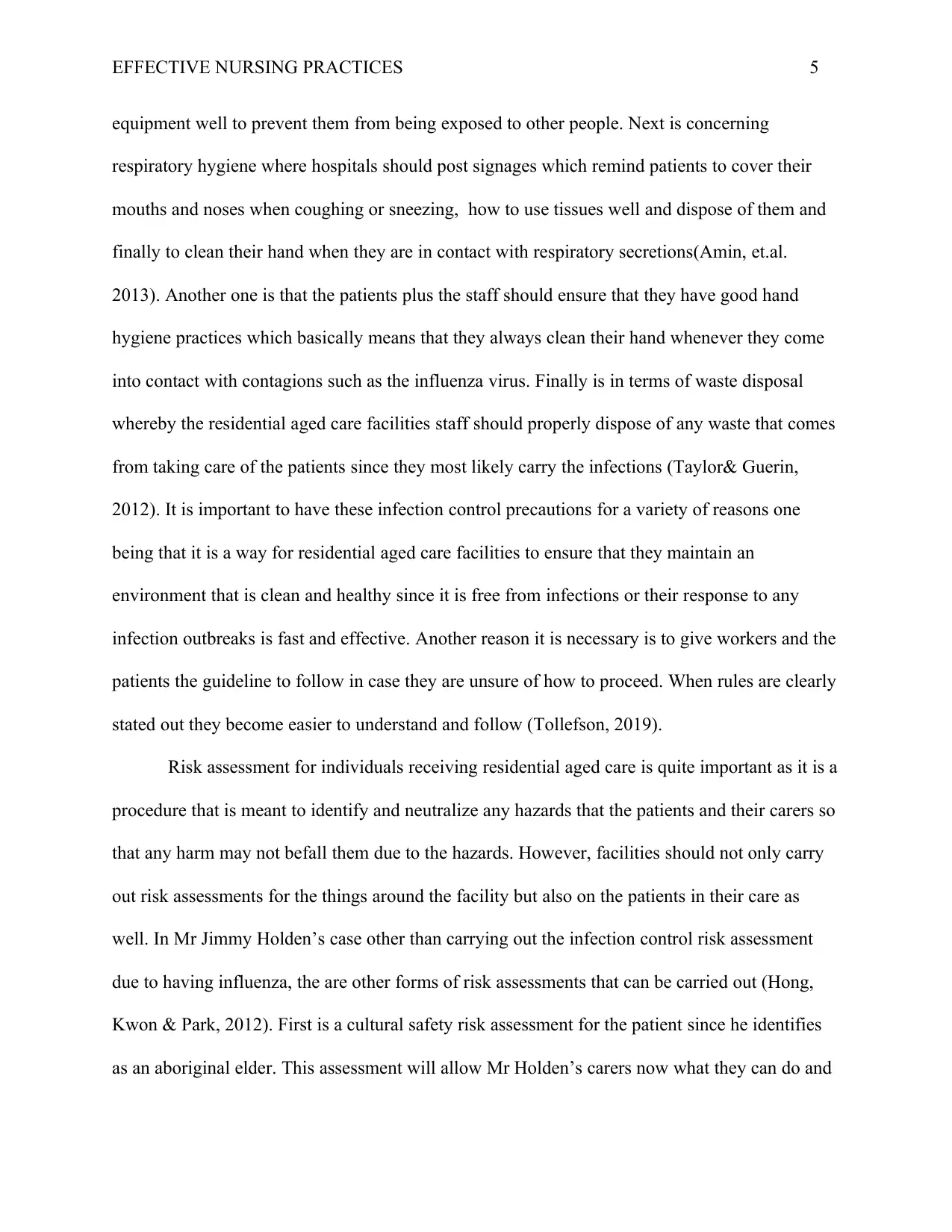
EFFECTIVE NURSING PRACTICES 5
equipment well to prevent them from being exposed to other people. Next is concerning
respiratory hygiene where hospitals should post signages which remind patients to cover their
mouths and noses when coughing or sneezing, how to use tissues well and dispose of them and
finally to clean their hand when they are in contact with respiratory secretions(Amin, et.al.
2013). Another one is that the patients plus the staff should ensure that they have good hand
hygiene practices which basically means that they always clean their hand whenever they come
into contact with contagions such as the influenza virus. Finally is in terms of waste disposal
whereby the residential aged care facilities staff should properly dispose of any waste that comes
from taking care of the patients since they most likely carry the infections (Taylor& Guerin,
2012). It is important to have these infection control precautions for a variety of reasons one
being that it is a way for residential aged care facilities to ensure that they maintain an
environment that is clean and healthy since it is free from infections or their response to any
infection outbreaks is fast and effective. Another reason it is necessary is to give workers and the
patients the guideline to follow in case they are unsure of how to proceed. When rules are clearly
stated out they become easier to understand and follow (Tollefson, 2019).
Risk assessment for individuals receiving residential aged care is quite important as it is a
procedure that is meant to identify and neutralize any hazards that the patients and their carers so
that any harm may not befall them due to the hazards. However, facilities should not only carry
out risk assessments for the things around the facility but also on the patients in their care as
well. In Mr Jimmy Holden’s case other than carrying out the infection control risk assessment
due to having influenza, the are other forms of risk assessments that can be carried out (Hong,
Kwon & Park, 2012). First is a cultural safety risk assessment for the patient since he identifies
as an aboriginal elder. This assessment will allow Mr Holden’s carers now what they can do and
equipment well to prevent them from being exposed to other people. Next is concerning
respiratory hygiene where hospitals should post signages which remind patients to cover their
mouths and noses when coughing or sneezing, how to use tissues well and dispose of them and
finally to clean their hand when they are in contact with respiratory secretions(Amin, et.al.
2013). Another one is that the patients plus the staff should ensure that they have good hand
hygiene practices which basically means that they always clean their hand whenever they come
into contact with contagions such as the influenza virus. Finally is in terms of waste disposal
whereby the residential aged care facilities staff should properly dispose of any waste that comes
from taking care of the patients since they most likely carry the infections (Taylor& Guerin,
2012). It is important to have these infection control precautions for a variety of reasons one
being that it is a way for residential aged care facilities to ensure that they maintain an
environment that is clean and healthy since it is free from infections or their response to any
infection outbreaks is fast and effective. Another reason it is necessary is to give workers and the
patients the guideline to follow in case they are unsure of how to proceed. When rules are clearly
stated out they become easier to understand and follow (Tollefson, 2019).
Risk assessment for individuals receiving residential aged care is quite important as it is a
procedure that is meant to identify and neutralize any hazards that the patients and their carers so
that any harm may not befall them due to the hazards. However, facilities should not only carry
out risk assessments for the things around the facility but also on the patients in their care as
well. In Mr Jimmy Holden’s case other than carrying out the infection control risk assessment
due to having influenza, the are other forms of risk assessments that can be carried out (Hong,
Kwon & Park, 2012). First is a cultural safety risk assessment for the patient since he identifies
as an aboriginal elder. This assessment will allow Mr Holden’s carers now what they can do and
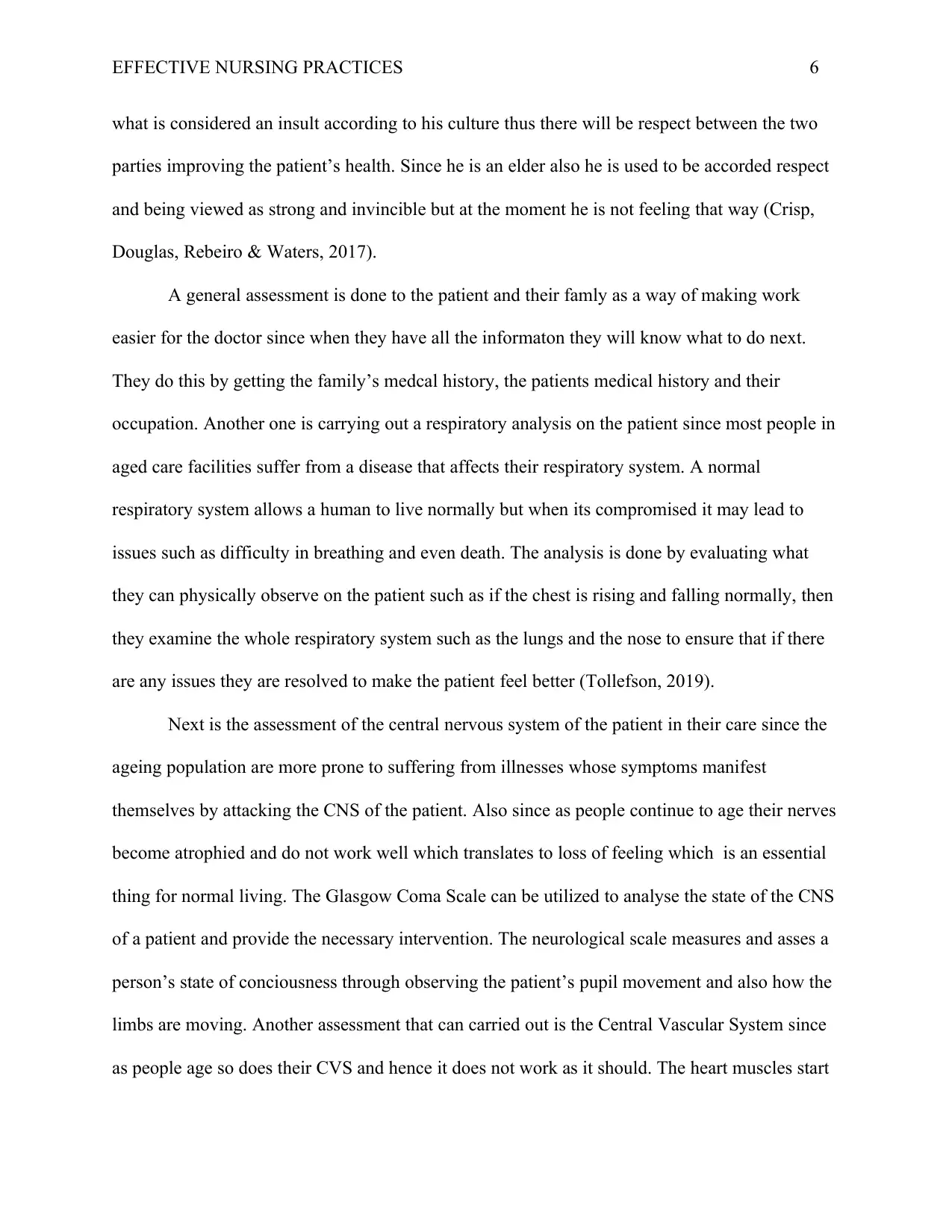
EFFECTIVE NURSING PRACTICES 6
what is considered an insult according to his culture thus there will be respect between the two
parties improving the patient’s health. Since he is an elder also he is used to be accorded respect
and being viewed as strong and invincible but at the moment he is not feeling that way (Crisp,
Douglas, Rebeiro & Waters, 2017).
A general assessment is done to the patient and their famly as a way of making work
easier for the doctor since when they have all the informaton they will know what to do next.
They do this by getting the family’s medcal history, the patients medical history and their
occupation. Another one is carrying out a respiratory analysis on the patient since most people in
aged care facilities suffer from a disease that affects their respiratory system. A normal
respiratory system allows a human to live normally but when its compromised it may lead to
issues such as difficulty in breathing and even death. The analysis is done by evaluating what
they can physically observe on the patient such as if the chest is rising and falling normally, then
they examine the whole respiratory system such as the lungs and the nose to ensure that if there
are any issues they are resolved to make the patient feel better (Tollefson, 2019).
Next is the assessment of the central nervous system of the patient in their care since the
ageing population are more prone to suffering from illnesses whose symptoms manifest
themselves by attacking the CNS of the patient. Also since as people continue to age their nerves
become atrophied and do not work well which translates to loss of feeling which is an essential
thing for normal living. The Glasgow Coma Scale can be utilized to analyse the state of the CNS
of a patient and provide the necessary intervention. The neurological scale measures and asses a
person’s state of conciousness through observing the patient’s pupil movement and also how the
limbs are moving. Another assessment that can carried out is the Central Vascular System since
as people age so does their CVS and hence it does not work as it should. The heart muscles start
what is considered an insult according to his culture thus there will be respect between the two
parties improving the patient’s health. Since he is an elder also he is used to be accorded respect
and being viewed as strong and invincible but at the moment he is not feeling that way (Crisp,
Douglas, Rebeiro & Waters, 2017).
A general assessment is done to the patient and their famly as a way of making work
easier for the doctor since when they have all the informaton they will know what to do next.
They do this by getting the family’s medcal history, the patients medical history and their
occupation. Another one is carrying out a respiratory analysis on the patient since most people in
aged care facilities suffer from a disease that affects their respiratory system. A normal
respiratory system allows a human to live normally but when its compromised it may lead to
issues such as difficulty in breathing and even death. The analysis is done by evaluating what
they can physically observe on the patient such as if the chest is rising and falling normally, then
they examine the whole respiratory system such as the lungs and the nose to ensure that if there
are any issues they are resolved to make the patient feel better (Tollefson, 2019).
Next is the assessment of the central nervous system of the patient in their care since the
ageing population are more prone to suffering from illnesses whose symptoms manifest
themselves by attacking the CNS of the patient. Also since as people continue to age their nerves
become atrophied and do not work well which translates to loss of feeling which is an essential
thing for normal living. The Glasgow Coma Scale can be utilized to analyse the state of the CNS
of a patient and provide the necessary intervention. The neurological scale measures and asses a
person’s state of conciousness through observing the patient’s pupil movement and also how the
limbs are moving. Another assessment that can carried out is the Central Vascular System since
as people age so does their CVS and hence it does not work as it should. The heart muscles start
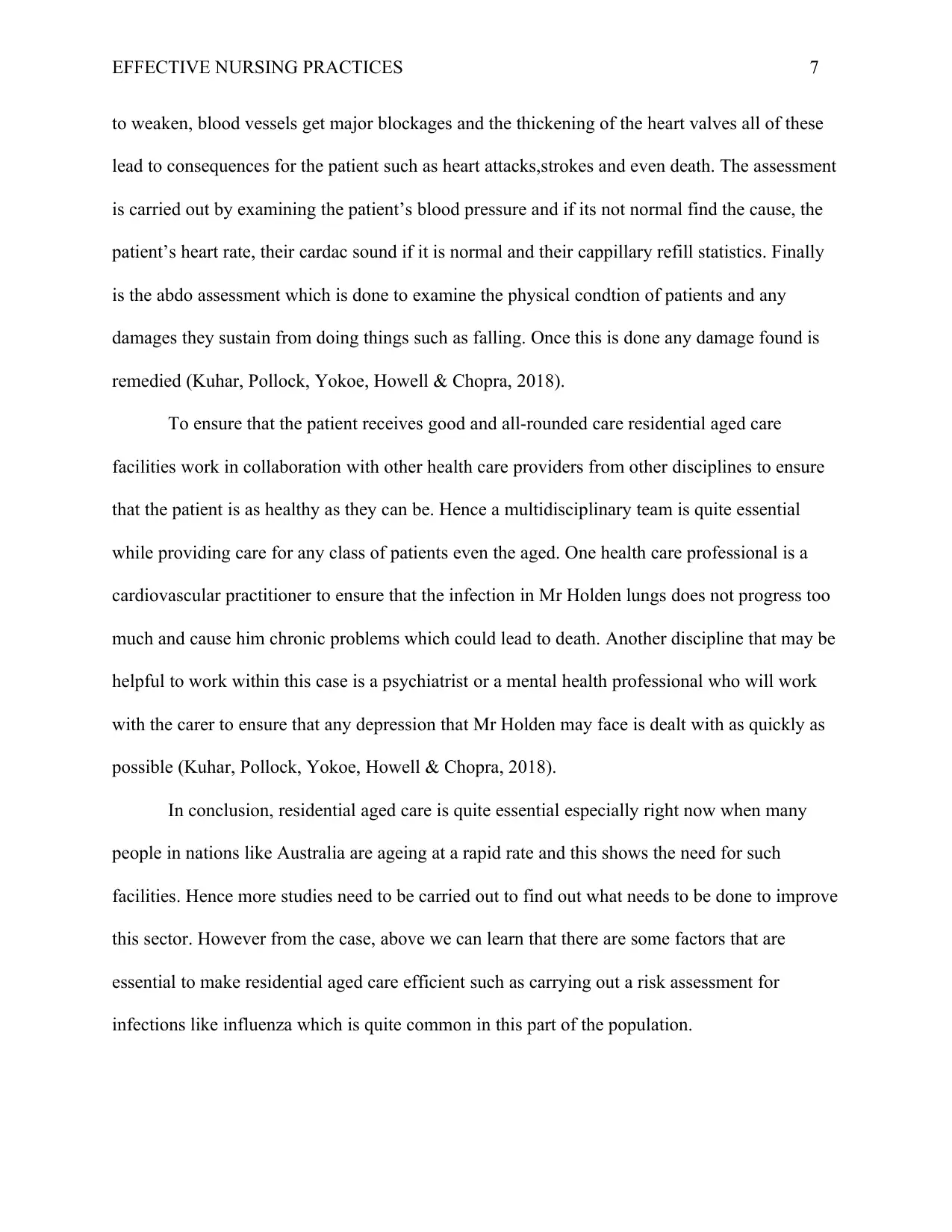
EFFECTIVE NURSING PRACTICES 7
to weaken, blood vessels get major blockages and the thickening of the heart valves all of these
lead to consequences for the patient such as heart attacks,strokes and even death. The assessment
is carried out by examining the patient’s blood pressure and if its not normal find the cause, the
patient’s heart rate, their cardac sound if it is normal and their cappillary refill statistics. Finally
is the abdo assessment which is done to examine the physical condtion of patients and any
damages they sustain from doing things such as falling. Once this is done any damage found is
remedied (Kuhar, Pollock, Yokoe, Howell & Chopra, 2018).
To ensure that the patient receives good and all-rounded care residential aged care
facilities work in collaboration with other health care providers from other disciplines to ensure
that the patient is as healthy as they can be. Hence a multidisciplinary team is quite essential
while providing care for any class of patients even the aged. One health care professional is a
cardiovascular practitioner to ensure that the infection in Mr Holden lungs does not progress too
much and cause him chronic problems which could lead to death. Another discipline that may be
helpful to work within this case is a psychiatrist or a mental health professional who will work
with the carer to ensure that any depression that Mr Holden may face is dealt with as quickly as
possible (Kuhar, Pollock, Yokoe, Howell & Chopra, 2018).
In conclusion, residential aged care is quite essential especially right now when many
people in nations like Australia are ageing at a rapid rate and this shows the need for such
facilities. Hence more studies need to be carried out to find out what needs to be done to improve
this sector. However from the case, above we can learn that there are some factors that are
essential to make residential aged care efficient such as carrying out a risk assessment for
infections like influenza which is quite common in this part of the population.
to weaken, blood vessels get major blockages and the thickening of the heart valves all of these
lead to consequences for the patient such as heart attacks,strokes and even death. The assessment
is carried out by examining the patient’s blood pressure and if its not normal find the cause, the
patient’s heart rate, their cardac sound if it is normal and their cappillary refill statistics. Finally
is the abdo assessment which is done to examine the physical condtion of patients and any
damages they sustain from doing things such as falling. Once this is done any damage found is
remedied (Kuhar, Pollock, Yokoe, Howell & Chopra, 2018).
To ensure that the patient receives good and all-rounded care residential aged care
facilities work in collaboration with other health care providers from other disciplines to ensure
that the patient is as healthy as they can be. Hence a multidisciplinary team is quite essential
while providing care for any class of patients even the aged. One health care professional is a
cardiovascular practitioner to ensure that the infection in Mr Holden lungs does not progress too
much and cause him chronic problems which could lead to death. Another discipline that may be
helpful to work within this case is a psychiatrist or a mental health professional who will work
with the carer to ensure that any depression that Mr Holden may face is dealt with as quickly as
possible (Kuhar, Pollock, Yokoe, Howell & Chopra, 2018).
In conclusion, residential aged care is quite essential especially right now when many
people in nations like Australia are ageing at a rapid rate and this shows the need for such
facilities. Hence more studies need to be carried out to find out what needs to be done to improve
this sector. However from the case, above we can learn that there are some factors that are
essential to make residential aged care efficient such as carrying out a risk assessment for
infections like influenza which is quite common in this part of the population.
Paraphrase This Document
Need a fresh take? Get an instant paraphrase of this document with our AI Paraphraser
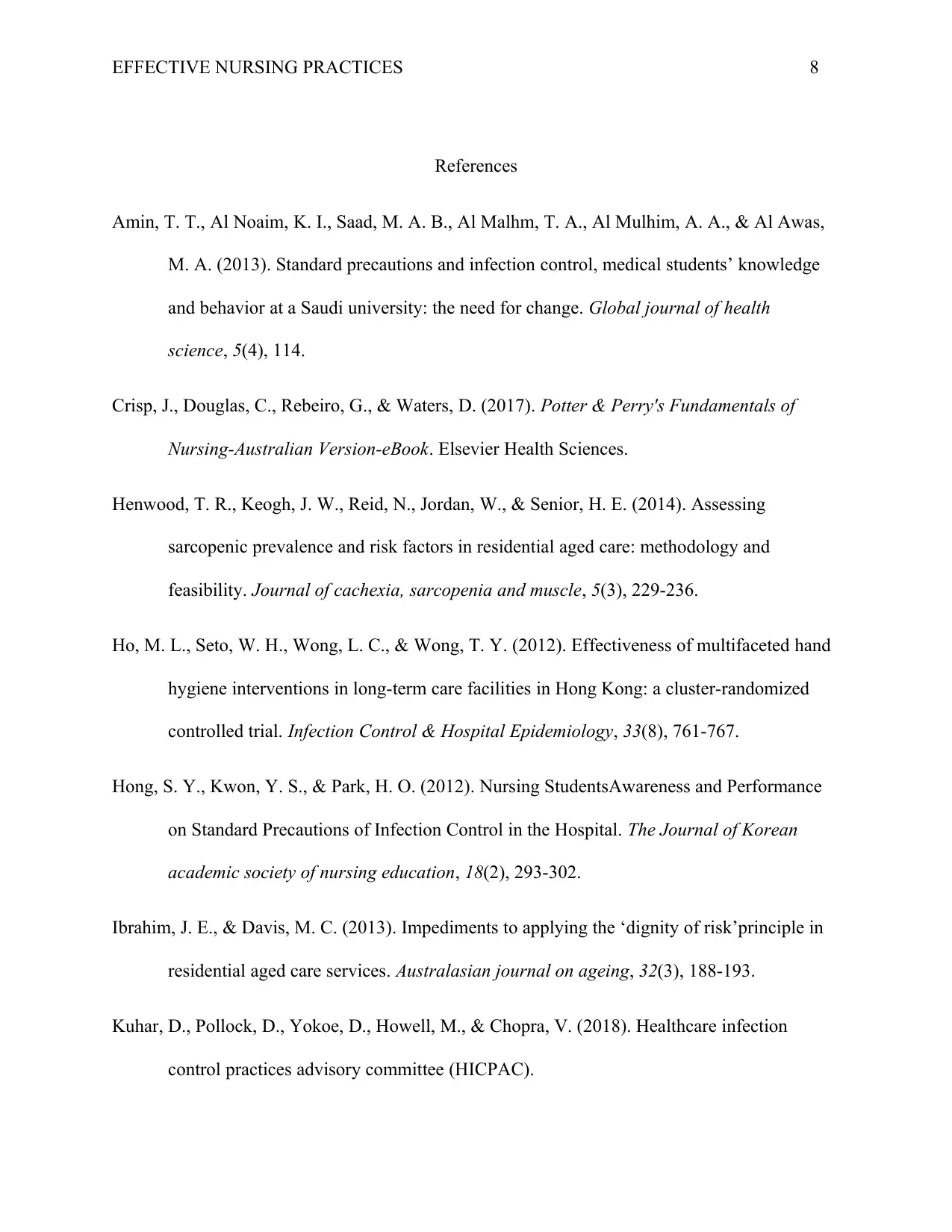
EFFECTIVE NURSING PRACTICES 8
References
Amin, T. T., Al Noaim, K. I., Saad, M. A. B., Al Malhm, T. A., Al Mulhim, A. A., & Al Awas,
M. A. (2013). Standard precautions and infection control, medical students’ knowledge
and behavior at a Saudi university: the need for change. Global journal of health
science, 5(4), 114.
Crisp, J., Douglas, C., Rebeiro, G., & Waters, D. (2017). Potter & Perry's Fundamentals of
Nursing-Australian Version-eBook. Elsevier Health Sciences.
Henwood, T. R., Keogh, J. W., Reid, N., Jordan, W., & Senior, H. E. (2014). Assessing
sarcopenic prevalence and risk factors in residential aged care: methodology and
feasibility. Journal of cachexia, sarcopenia and muscle, 5(3), 229-236.
Ho, M. L., Seto, W. H., Wong, L. C., & Wong, T. Y. (2012). Effectiveness of multifaceted hand
hygiene interventions in long-term care facilities in Hong Kong: a cluster-randomized
controlled trial. Infection Control & Hospital Epidemiology, 33(8), 761-767.
Hong, S. Y., Kwon, Y. S., & Park, H. O. (2012). Nursing StudentsAwareness and Performance
on Standard Precautions of Infection Control in the Hospital. The Journal of Korean
academic society of nursing education, 18(2), 293-302.
Ibrahim, J. E., & Davis, M. C. (2013). Impediments to applying the ‘dignity of risk’principle in
residential aged care services. Australasian journal on ageing, 32(3), 188-193.
Kuhar, D., Pollock, D., Yokoe, D., Howell, M., & Chopra, V. (2018). Healthcare infection
control practices advisory committee (HICPAC).
References
Amin, T. T., Al Noaim, K. I., Saad, M. A. B., Al Malhm, T. A., Al Mulhim, A. A., & Al Awas,
M. A. (2013). Standard precautions and infection control, medical students’ knowledge
and behavior at a Saudi university: the need for change. Global journal of health
science, 5(4), 114.
Crisp, J., Douglas, C., Rebeiro, G., & Waters, D. (2017). Potter & Perry's Fundamentals of
Nursing-Australian Version-eBook. Elsevier Health Sciences.
Henwood, T. R., Keogh, J. W., Reid, N., Jordan, W., & Senior, H. E. (2014). Assessing
sarcopenic prevalence and risk factors in residential aged care: methodology and
feasibility. Journal of cachexia, sarcopenia and muscle, 5(3), 229-236.
Ho, M. L., Seto, W. H., Wong, L. C., & Wong, T. Y. (2012). Effectiveness of multifaceted hand
hygiene interventions in long-term care facilities in Hong Kong: a cluster-randomized
controlled trial. Infection Control & Hospital Epidemiology, 33(8), 761-767.
Hong, S. Y., Kwon, Y. S., & Park, H. O. (2012). Nursing StudentsAwareness and Performance
on Standard Precautions of Infection Control in the Hospital. The Journal of Korean
academic society of nursing education, 18(2), 293-302.
Ibrahim, J. E., & Davis, M. C. (2013). Impediments to applying the ‘dignity of risk’principle in
residential aged care services. Australasian journal on ageing, 32(3), 188-193.
Kuhar, D., Pollock, D., Yokoe, D., Howell, M., & Chopra, V. (2018). Healthcare infection
control practices advisory committee (HICPAC).
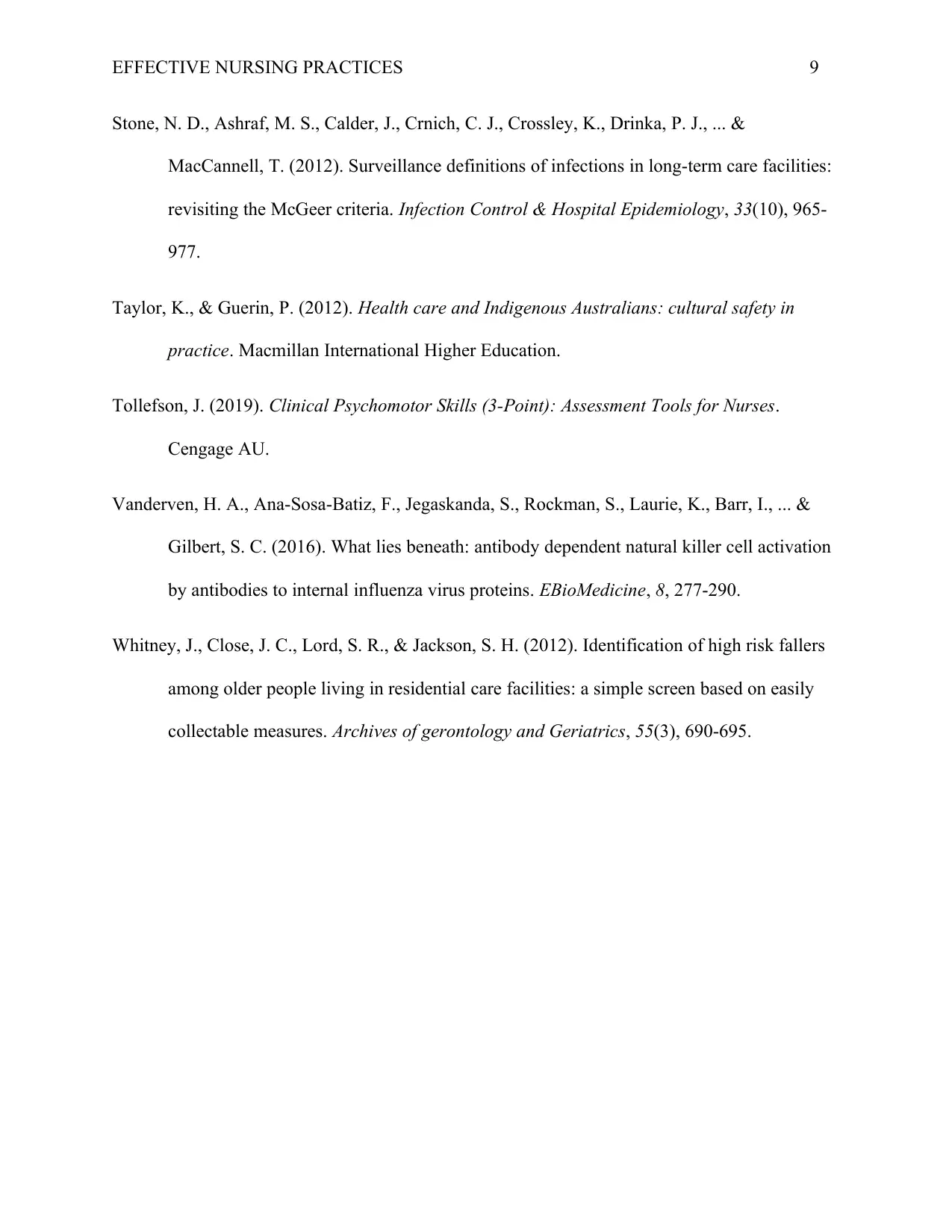
EFFECTIVE NURSING PRACTICES 9
Stone, N. D., Ashraf, M. S., Calder, J., Crnich, C. J., Crossley, K., Drinka, P. J., ... &
MacCannell, T. (2012). Surveillance definitions of infections in long-term care facilities:
revisiting the McGeer criteria. Infection Control & Hospital Epidemiology, 33(10), 965-
977.
Taylor, K., & Guerin, P. (2012). Health care and Indigenous Australians: cultural safety in
practice. Macmillan International Higher Education.
Tollefson, J. (2019). Clinical Psychomotor Skills (3-Point): Assessment Tools for Nurses.
Cengage AU.
Vanderven, H. A., Ana-Sosa-Batiz, F., Jegaskanda, S., Rockman, S., Laurie, K., Barr, I., ... &
Gilbert, S. C. (2016). What lies beneath: antibody dependent natural killer cell activation
by antibodies to internal influenza virus proteins. EBioMedicine, 8, 277-290.
Whitney, J., Close, J. C., Lord, S. R., & Jackson, S. H. (2012). Identification of high risk fallers
among older people living in residential care facilities: a simple screen based on easily
collectable measures. Archives of gerontology and Geriatrics, 55(3), 690-695.
Stone, N. D., Ashraf, M. S., Calder, J., Crnich, C. J., Crossley, K., Drinka, P. J., ... &
MacCannell, T. (2012). Surveillance definitions of infections in long-term care facilities:
revisiting the McGeer criteria. Infection Control & Hospital Epidemiology, 33(10), 965-
977.
Taylor, K., & Guerin, P. (2012). Health care and Indigenous Australians: cultural safety in
practice. Macmillan International Higher Education.
Tollefson, J. (2019). Clinical Psychomotor Skills (3-Point): Assessment Tools for Nurses.
Cengage AU.
Vanderven, H. A., Ana-Sosa-Batiz, F., Jegaskanda, S., Rockman, S., Laurie, K., Barr, I., ... &
Gilbert, S. C. (2016). What lies beneath: antibody dependent natural killer cell activation
by antibodies to internal influenza virus proteins. EBioMedicine, 8, 277-290.
Whitney, J., Close, J. C., Lord, S. R., & Jackson, S. H. (2012). Identification of high risk fallers
among older people living in residential care facilities: a simple screen based on easily
collectable measures. Archives of gerontology and Geriatrics, 55(3), 690-695.
1 out of 9
Related Documents
Your All-in-One AI-Powered Toolkit for Academic Success.
+13062052269
info@desklib.com
Available 24*7 on WhatsApp / Email
![[object Object]](/_next/static/media/star-bottom.7253800d.svg)
Unlock your academic potential
© 2024 | Zucol Services PVT LTD | All rights reserved.





